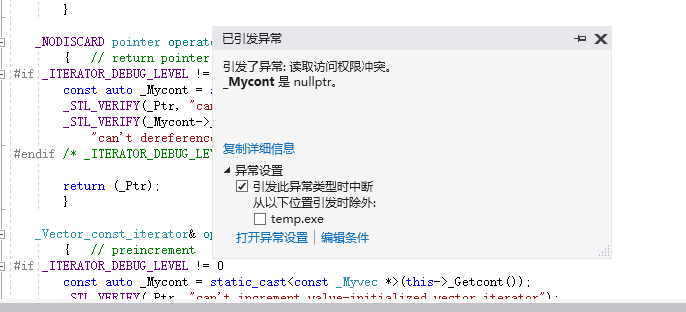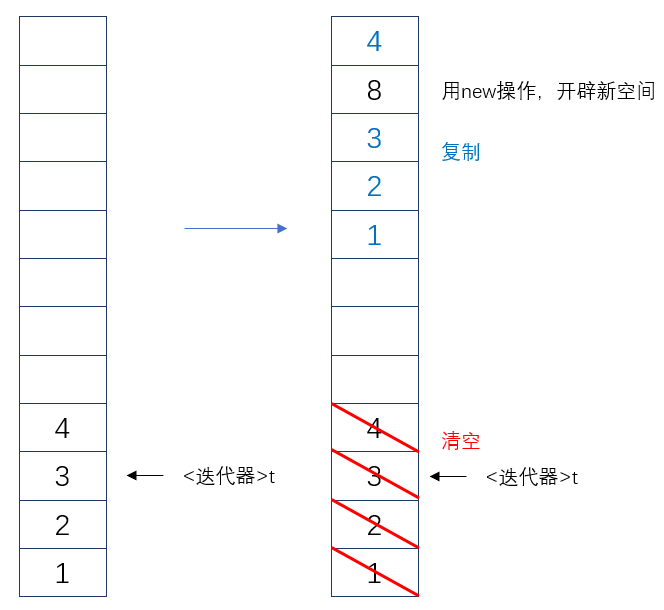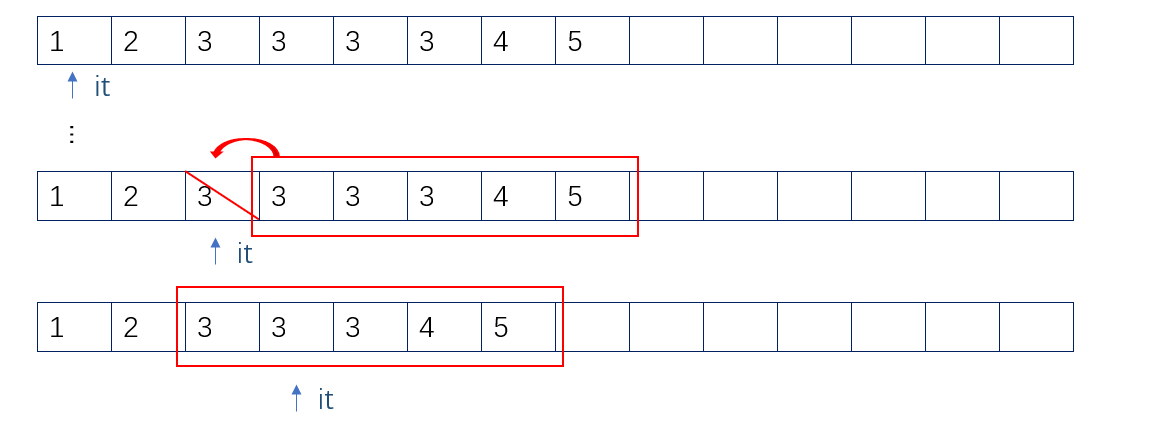vector容器简介——动态数组
vector是将元素置于一个动态数组加以管理的容器。
vector可用vector[idx]或者vector.at(idx)函数取值。
vector在<尾部>插入&删除元素非常快;在<头部>插入&删除元素的时间成本为O(n);在<中间>插入&删除元素也较慢。
vector对象
vector采用模板类实现,其对象的类型遵循其指定类型。
2.1 vector对象的构造
vetcor对象的默认构造:
//vetcor对象的默认构造
vector<int> v; //一个存放int的vector容器
vector<float> v; //一个存放float的vector容器
vector<string> v; //一个存放string的vector容器
class CA{};
vector<CA> v; //一个存放 CA对象 的vector容器
vector<CA*> v; //一个存放 CA对象指针 的vector容器vetcor对象的带参数构造:

//vetcor对象的带参数构造
//第1种:vector(begin,end); 用两个指针
int arr[] = {1,2,3,4,5};
//将以上数组全部存入vector
//知识点1:数组名字代表数组首地址,即该指针指向数组第一个元素
//注意!因为是左闭右开区间,所有右边要比最大索引大
vector<int> v1(arr, arr+5);
//第2种:vector(n,elem);
vector<int> v2(3,10); //存储3个10
//第3种:vector(const vector &vec); 用一个容器对象
vector<int> v3(v1); //v3和v1一样2.2 vector对象的赋值

void test_vector02() {
vector<int> v2(10,10);
for (int i = 0; i < v2.size(); i++) {
cout << v2[i] << " ";
}
cout << endl;
int arr[] = { 1,2,3,4,5 };
v2.assign(arr, arr + 5);
for (int i = 0; i < v2.size(); i++) {
cout << v2[i] << " ";
}
cout << endl;
}运行程序后输出:

可见:vector.assign(beg,end)函数先清空原对象,再赋值
vector的大小

说明:当容器为空,vector.size()返回值为0。
vector.resize(num):容器变长,用默认值0填充多的位置;容器变长,截掉多的元素。
vector的索引

Q:vec[idx]如果下标越界可能会导致程序异常终止,但对于初学者,很难看出是因为越界运行停止的。那么如何确保越界一定会提醒呢?
A:使用vec.at(idx)函数,一旦越界一定报错。注意!只是报错,运行也会停止,但会让我们知道为什么停止。
vector的插入&删除
5.1 在末尾插入&删除:
v.push_back(x);//在容器末尾插入
v.pop_back();//在容器末尾删除
5.2 在中间插入&删除:
v.insert(position, x);//在position位置插入x,返回新的<迭代器>
v.insert(position, n, x);//在position位置插入n个x,无返回值
v.insert(position, beg, end);//在position位置插入[beg, end)区间的数据,无返回值
注意:以上position, beg, end都为<指针>,而非<索引下标>
//容器中插入普通数组
void test_vector051() {
vector<int> v5(3, 10);
int a[] = { 1,2,3,4,5 };
//10 10 10->10 2 3 10 10
v3.insert(v5.begin() + 1, a + 1, a + 3);
for (int i = 0; i < v5.size(); i++) {
cout << v5[i] << " ";
}
cout << endl;
}运行程序后输出:

//容器中插入容器
void test_vector052() {
vector<int> v3(3, 10);
int a[] = { 1,2,3,4,5 };
vector<int> v4(a, a + 5);
//10 10 10->10 2 3 10 10
v3.insert(v3.begin() + 1, v4.begin()+1, v4.begin() + 3);
for (int i = 0; i < v3.size(); i++) {
cout << v3[i] << " ";
}
cout << endl;
}vector迭代器
6.1 vector迭代器的使用
每种容器都定义了一对名为begin()和end()的函数,用于返回迭代器。
class Person {
public:
//构造函数,用列表赋值
Person(int age, int id) :age(age),id(id){}
public:
int age;
int id;
};
void test_vector061() {
//创建类型是Person类的容器v6
vector<Person> v6;
Person p1(23, 2112), p2(22, 2111), p3(22, 2110);
v6.push_back(p1);
v6.push_back(p2);
v6.push_back(p3);
//构造一个迭代器对象ite
vector<Person>::iterator ite;
ite = v6.begin();
//用迭代器遍历容器v6中的所有元素
for (ite; ite != v6.end(); ite++) {
cout << (*ite).age << " " << (*ite).id << " ";//(*ite)取*,即指向对象
}
cout << endl;
for_each
//vector<Person>::iterator pb = v.begin();
//vector<Person>::iterator pe = v.end();
//for_each(pb, pe, Print);
}6.2 vector迭代器的失效
插入时失效:
void test_vector062() {
vector<int> v;
v.push_back(1);
v.push_back(2);
v.push_back(3);
v.push_back(4);
vector<int>::iterator t = v.begin() + 3;
cout << *t << endl;
//要想使运行不终止,t = v7.insert(t, 8); 因为insert()返回新的<迭代器>
v.insert(t, 8);
cout << *t << endl;
}运行程序,在输出一个4之后(即执行完line 9),程序就报错:


这是因为编译器在运行时,insert()操作是新开辟了一个空间,并将原来的值复制过去。但<迭代器>t仍在原位置,故报错。

Summary:若在使用insert(pos, elment)函数时,用到了<迭代器>,那么一定要给<迭代器>重新赋值insert(pos, elment)函数的返回值。
删除时失效:
void test_vector062_2() {
vector<int> v = { 1,2,3,3,3,4,5,6 };
vector<int>::iterator it;
for (it = v.begin(); it != v.end(); it++)
{
if (*it == 3)
v.erase(it);
}
for (it = v.begin(); it != v.end(); it++)
cout << *it << " ";
cout << endl;
}运行程序报错:
因为erase()函数是把后面的数据移到前面。用覆盖实现删除。
在G++里,erase()函数覆盖删除时,<迭代器>it依然在移动,就会造成只删除一半的3;
而在VS编译器里,利用erase()函数删除,会直接认为<迭代器>it失效。

为了不管什么编译器里都实现“删掉所有的3“的操作,应当改为:
//不管什么编译器,都不会报错
void test_vector062_3() {
vector<int> v = { 1,2,3,3,3,4,5,6 };
vector<int>::iterator it =v.begin();
while (it != v.end())
{
if (*it == 3)
it=v.erase(it);
else
it++;
}
for (it = v.begin(); it != v.end(); it++)
cout << *it << " ";
cout << endl;
}
Summary:若在使用erase()函数时,为了保证<迭代器>不失效,一定要给<迭代器>重新赋值erase()函数的返回值。





















 1426
1426











 被折叠的 条评论
为什么被折叠?
被折叠的 条评论
为什么被折叠?








